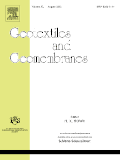
GEOTEXTILES AND GEOMEMBRANES
Scope & Guideline
Exploring the Boundaries of Civil Engineering Materials
Introduction
Aims and Scopes
- Geosynthetic Performance Evaluation:
Research assessing the mechanical, hydraulic, and durability characteristics of geotextiles and geomembranes under various environmental conditions and loading scenarios. - Innovative Applications in Civil Engineering:
Exploration of novel applications of geosynthetics in infrastructure projects, such as roads, embankments, and landfills, focusing on enhancing stability, drainage, and sustainability. - Environmental Impact Studies:
Investigations into the role of geosynthetics in mitigating environmental issues, including contamination control in landfills and the management of stormwater runoff. - Numerical and Analytical Modeling:
Development of theoretical models to simulate the behavior of geosynthetic materials and their interactions with soils and fluids under various conditions. - Field Studies and Real-World Applications:
Empirical research based on field tests and case studies that validate laboratory findings and demonstrate the practical effectiveness of geosynthetic solutions.
Trending and Emerging
- Sustainable and Eco-Friendly Solutions:
An increasing number of studies focus on the development of geosynthetics made from recycled or sustainable materials, aiming to reduce environmental impact and enhance sustainability in construction. - Advanced Composite Materials:
Research has shifted towards the use of composite materials that combine geosynthetics with other materials (e.g., polymers, fibers) to improve performance in challenging applications. - Smart Geosynthetics and Sensors:
Emerging interest in integrating sensors into geosynthetic materials for real-time monitoring of performance and structural health in engineered systems. - Climate Resilience and Adaptation:
A growing emphasis on how geosynthetics can contribute to infrastructure resilience against climate change impacts, such as flooding and soil erosion. - Digital and Computational Methods:
Increased utilization of digital imaging, numerical modeling, and artificial intelligence techniques to study and optimize the behavior of geosynthetic systems.
Declining or Waning
- Traditional Soil Reinforcement Techniques:
Research focusing on conventional soil reinforcement methods is gradually being overshadowed by innovative materials and techniques, such as advanced geosynthetics that offer enhanced performance. - Static Load Testing:
The frequency of studies centered on static load testing of geosynthetics has decreased, with a shift towards dynamic and cyclic loading analyses that better represent real-world conditions. - Basic Geosynthetic Properties:
While foundational studies on the properties of geosynthetics remain important, there is a noticeable decline in research dedicated solely to these basic properties, as the field moves towards applications and performance-based evaluations.
Similar Journals

Archives of Civil and Mechanical Engineering
Advancing Engineering Excellence GloballyArchives of Civil and Mechanical Engineering is a distinguished peer-reviewed journal published by SpringerNature, focusing on advancing the fields of civil and mechanical engineering. With an impressive Q1 ranking in both categories in 2023, this journal caters to a global audience, addressing the evolving challenges and innovations within these vital engineering disciplines. The journal has been a pivotal platform since its inception in 2006, and it continues to be essential for researchers and practitioners seeking to publish and access high-quality research. The absence of an Open Access option ensures that published works maintain rigorous academic standards, thereby enhancing their value within institutional repositories. With a robust impact factor and high visibility on Scopus—ranking #122 out of 672 in Mechanical Engineering and #74 out of 379 in Civil and Structural Engineering—this journal is an ideal venue for professionals, researchers, and students dedicated to advancing their knowledge and contributing to cutting-edge engineering practices. Based in Germany and operating internationally, the Archives of Civil and Mechanical Engineering invites submissions that address critical issues and solutions in contemporary engineering.

World Journal of Engineering
Bridging Theory and Practice in Engineering AdvancesWorld Journal of Engineering, published by EMERALD GROUP PUBLISHING LTD, stands as a premier platform for disseminating high-quality research across various engineering disciplines. Since its inception in 2014, the journal has built a reputation for its rigorous peer-review process and commitment to advancing knowledge in the fields of Civil and Structural Engineering, Electrical and Electronic Engineering, Geotechnical Engineering, Mechanical Engineering, and Mechanics of Materials. With its categorization in the Q3 quartile across multiple engineering domains and notable Scopus rankings, the journal positions itself as a valuable resource for researchers, professionals, and students seeking to stay abreast of innovations and critical developments in engineering. While the journal currently operates under a subscription model, its comprehensive scope ensures that it remains a vital reference point for contemporary engineering challenges and solutions throughout the United Kingdom and beyond.
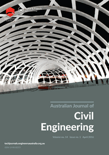
Australian Journal of Civil Engineering
Empowering Engineers with Cutting-Edge ResearchThe Australian Journal of Civil Engineering, published by Taylor & Francis Ltd, stands as a pivotal platform within the field of civil and structural engineering. With an ISSN of 1448-8353 and an E-ISSN of 2204-2245, this journal consistently delivers high-quality research and innovative practices from both established and emerging scholars in the discipline. Recognized in the Q2 category for Civil and Structural Engineering in 2023, it holds a respectable position, ranking 146 out of 379 within its field according to Scopus, which places it in the 61st percentile. Converging valuable insights from 2011 through 2024, the journal encompasses a broad scope of topics, including sustainable infrastructure, innovative materials, and advanced construction techniques, thereby addressing contemporary challenges faced by engineering professionals. Though it is a traditional publication without open access options, the quality of the research featured ensures that it remains an essential resource for academics, practitioners, and students striving to enhance their knowledge and contribute to the dynamic field of civil engineering.
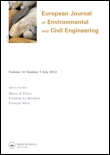
European Journal of Environmental and Civil Engineering
Fostering Dialogue for Sustainable Development in EngineeringThe European Journal of Environmental and Civil Engineering, published by Taylor & Francis Ltd, is a prestigious peer-reviewed journal that serves as a vital platform for advancing knowledge in the fields of Civil and Structural Engineering as well as Environmental Engineering. With an impressive impact factor and categorized in the Q2 quartile for both engineering fields, this journal occupies a significant position in the scholarly community. Its focused scope encompasses innovative research, case studies, and practical applications that address contemporary environmental and infrastructural challenges. Researchers, professionals, and students alike benefit from the journal's commitment to high-quality discourse, as evidenced by its Scopus rankings, which place it in the top 30% in Civil and Structural Engineering and the top 40% in Environmental Engineering. Through the publication of cutting-edge studies and a commitment to fostering interdisciplinary dialogue, the European Journal of Environmental and Civil Engineering remains an essential resource for those dedicated to improving our built environment and safeguarding our natural resources.
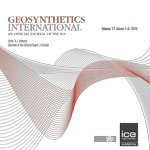
GEOSYNTHETICS INTERNATIONAL
Exploring Innovations in Synthetic MaterialsGEOSYNTHETICS INTERNATIONAL, published by EMERALD GROUP PUBLISHING LTD, is a leading journal in the fields of Civil and Structural Engineering and Geotechnical Engineering, recognized for its significant contributions since its inception in 1994. With an impressive impact factor reflecting its esteemed reputation—ranking in the top quartile (Q1) for both primary categories—this journal serves as a critical platform for the dissemination of cutting-edge research and innovations related to synthetic materials in geotechnical applications. Researchers, professionals, and students alike benefit from access to peer-reviewed articles that explore both theoretical advancements and practical implementations of geosynthetics, addressing complex engineering challenges and environmental considerations. Given its commendable rankings in Scopus, where it stands at Rank #73 in Civil and Structural Engineering and Rank #46 in Geotechnical Engineering, with an 80th percentile performance, the journal not only enhances scholarly dialogue but also influences industry practices. GEOSYNTHETICS INTERNATIONAL continues to play a pivotal role in shaping future directions in engineering and sustainability.

CANADIAN JOURNAL OF CIVIL ENGINEERING
Pioneering Research in Civil and Structural EngineeringCanadian Journal of Civil Engineering, published by Canadian Science Publishing, serves as a premier platform for the dissemination of innovative research and development in the fields of civil and structural engineering, as well as environmental science. Established in 1971, this journal maintains a robust reputation, achieving a Q3 ranking in both civil engineering and general environmental science categories as of 2023. While it does not currently offer open access, the journal is accessible to a wide audience of researchers, professionals, and students who are keen to stay abreast of the latest advancements in civil engineering practices. With a significant number of yearly publications and a committed editorial board, the Canadian Journal of Civil Engineering contributes to the foundational knowledge and practical applications in the engineering community, thereby playing a critical role in addressing contemporary challenges in civil infrastructure and environmental sustainability.

Transportation Infrastructure Geotechnology
Transforming Transportation through Geotechnical Excellence.Transportation Infrastructure Geotechnology, an esteemed journal published by SpringerNature, serves as a vital platform in the fields of Civil and Structural Engineering, Environmental Engineering, Geotechnical Engineering, and Transportation. Established in 2014 and spanning a decade of significant scientific discourse, this journal has gained recognition for its robust contribution to the understanding of the interplay between geotechnical processes and transportation infrastructure. With an impactful Q2 ranking in multiple categories—including Civil and Structural Engineering and Environmental Engineering—it emphasizes innovative research and practical applications globally. Researchers and professionals can explore critical topics that influence infrastructure sustainability, safety, and efficiency. Although it operates under a subscription model, its affiliation with SpringerNature ensures rigorous peer-review and high-quality publications, making it an indispensable resource for academics and industry experts alike.

Proceedings of the Institution of Civil Engineers-Engineering and Computational Mechanics
Bridging Theory and Practice in Engineering ExcellenceProceedings of the Institution of Civil Engineers - Engineering and Computational Mechanics is a prestigious journal published by Emerald Group Publishing Ltd, dedicated to advancing the fields of civil and structural engineering, as well as mechanics of materials. With an ISSN of 1755-0777 and E-ISSN 1755-0785, this journal serves as a critical platform for disseminating innovative research and practical insights from 2009 through 2024. As part of its commitment to academic rigor, it is categorized in the Q4 quartile for both civil and structural engineering and mechanics of materials, reflecting a unique position in the scholarly community. The journal is essential for professionals, researchers, and students aiming to stay informed on current trends, methodologies, and applications in engineering and computational mechanics. By engaging with this publication, readers gain access to crucial findings that contribute to the advancement of infrastructure and materials science, vital for developing resilient and sustainable engineering solutions.
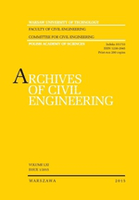
Archives of Civil Engineering
Bridging Theory and Practice in Civil EngineeringArchives of Civil Engineering is a premier academic journal published by POLISH ACAD SCIENCES, dedicated to advancing the field of civil and structural engineering. Established in 1996, this open-access journal has been pivotal in disseminating high-quality research and innovation in engineering practices, particularly since adopting open access in 2010. With an ISSN of 1230-2945 and E-ISSN of 2300-3103, it enjoys a notable reputation, currently ranked in Q3 of the Civil and Structural Engineering category for 2023, reflecting its considerable contribution to scholarly content in the discipline. The journal caters to a diverse audience of researchers, professionals, and students, providing them with a platform to share and access essential findings. Its commitment to high academic standards is underscored by its ranking in Scopus, where it stands at Rank #265/379. Located in Warsaw, Poland, the journal aims to promote international collaboration and foster knowledge exchange in civil engineering, making it an indispensable resource for anyone involved in this dynamic field.

Acta Geotechnica Slovenica
Connecting Theory and Practice in Earth Sciences.Acta Geotechnica Slovenica is a distinguished peer-reviewed journal published by the University of Maribor, Slovenia, that focuses on the fields of geology, geophysics, and geotechnical engineering. With an ISSN of 1854-0171, it showcases significant research contributions that enhance our understanding of geotechnical challenges and innovations. The journal has been active since 2008 and has gained recognition within the academic community, holding a Q3 quartile ranking in Geology and a Q4 ranking in Geophysics and Geotechnical Engineering and Engineering Geology as per the 2023 categorization. Even though there are no Open Access options available, the journal remains an important resource for researchers, professionals, and students alike, serving as a platform for disseminating impactful findings in earth science disciplines. Its relevance is underscored by its rankings in Scopus, positioning it among the notable journals in its field. Engaging with Acta Geotechnica Slovenica offers an invaluable opportunity to stay at the forefront of geotechnical research and advancements.